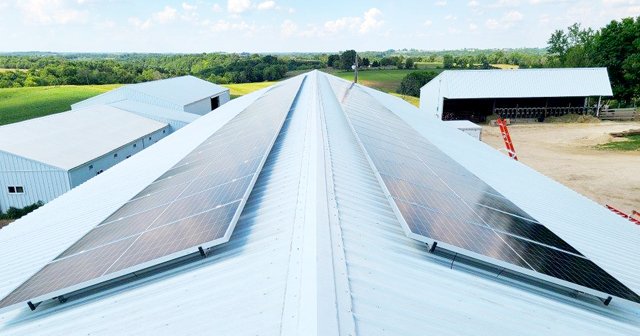NORTH CLAYTON - Clayton Ridge dairy farmer Jerry Coleman is well on his way to realizing his dream of reducing the energy costs for his 30-head dairy farm business. He has accomplished this through installation of a 24-kilowatt (kw) solar electric system, combined with two successful grant applications.
According to a USDA press release announcing the grant, the project will realize $3,215 per year in savings, and will replace 28,451-kilowatt hours of electricity per year.
“For me the main motivation to install a solar electric system on my farm was to reduce my costs,” Coleman explained. “Because 30 percent of the cost of the installation was paid for by grant funding, my pay back period on the system is now less than 10 years.”
Coleman said that before the system was installed on the roof of his machine shed, his average monthly electric bill was $500. He said that in August of 2022, his bill was only $50, and the highest bill he’d had since installing the system was $200 in January of 2022.
Coleman applied for and received a $10,722 Rural Energy for America Program (REAP) grant targeted to farmers, as well as a State of Wisconsin Focus on Energy (FOE) grant, also targeted to farmers. The REAP grant paid for 25 percent of the project, and the FOE paid for another five percent.
“My system doesn’t include battery storage, and if it had, that would have doubled the cost of it,” Coleman said. “The current battery storage technologies require a specialized environment that I can’t provide on my farm, but the technologies are evolving rapidly, and I hope in the future to have adding storage be something that will work for my operation.”
Because he doesn’t have battery storage, and he is “tied to the grid,” Coleman said that when the grid goes down, then he is without electricity just like everyone else. He reports that on a sunny summer day, when his system produces more energy than he uses, he is able to sell the excess energy generated to Scenic Rivers Energy Cooperative (SREC).
“When I buy electricity from SREC, I pay 11-cents-per-watt (cpw), and when I sell my excess energy to them, they pay me three cpw,” Coleman explained. “Every energy cooperative does things a little bit differently, and some offer ‘net metering,’ which means that they would pay me the same price for my energy as I pay for theirs.”
Coleman also responded to the objection to solar electric raised by some –that the panels are vulnerable in cases of high wind such as straight-line winds, tornados and derechos.
“My system is warrantied for 25 years, and it is insured,” Coleman said. “Even the power lines of the grid are vulnerable to high wind, and that is why my system is insured.”

Coleman said that he had worked with Olson Solar of Onalaska on installation of the system. The system was installed on his farm in June of 2021. Coleman said that even though he had not yet heard back about his grant application at that point, he decided to move forward anyhow because “it was a good investment for the future.”
“After doing my research, I reached out to Olson Solar in January of 2021,” Coleman remembered. “Mike Palen, a salesman with the company, responded to my inquiry, got out to my farm and did a site visit, and has been just great to work with.”
Coleman credits the grant writing services of Brad and Lori Oeltjenburns of Ebenezer Management LLC with his successful REAP grant application. The company is based in the Des Moines, Iowa, area. He said the couple works for just a small percentage of the grant funds.
“REAP grant applications are very complicated,” Coleman said. “When I first got the application materials, I almost decided not to bother applying. But, when I hooked up with Brad and Lori, then it all became possible for me.”
U.S. Department of Agriculture (USDA) Deputy Secretary Dr. Jewel Bronaugh recently announced USDA is investing $121 million in critical infrastructure to combat climate change across rural America. The investments include $111 million for 289 projects to help people living in socially vulnerable communities.
“Rural America is on the front lines of climate change, and our communities deserve investments that will strengthen all of our resilience,” Bronaugh said. “The Biden-Harris Administration has created a roadmap for how we can tackle the climate crisis and expand access to renewable energy infrastructure. The investments we’re announcing today and those that will be made possible by historic funding from President Biden’s Inflation Reduction Act will strengthen our energy security, create good-paying jobs and save Americans money on their energy costs.”



